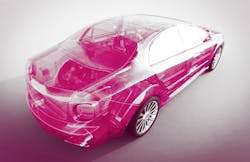NASHVILLE, TENN., Dec. 6, 2021—It’s well known that the relationship between the aftermarket and OEMs has been strained.
National Automotive Service Task Force Executive Director Donny Seyfer said during his opening keynote at the ADAPT: Automotive Technology Summit that there’s been a recurring theme of “us versus them” throughout the industry.
However, as the technology in cars becomes more advanced, several of the major automakers have started to realize that the aftermarket is an essential component of the automotive repair ecosystem.
“Understand that independent repairers are an extension. Our customers are your customers,” Mark Zoba, product and services planning manager for Nissan, said during an OEM discussion panel. “We want to make sure that shops have the information, training and tools available to make those safe and proper repairs. We want to have a better relationship.”
During that panel discussion, moderator Mike Anderson of Collision Advice said that roughly 60 percent of drivers who experience an issue with a repair think their car “will never be the same” and switch cars within a year or so. Of those who do switch, around 60 percent choose a different brand.
“At the end of the day, these are our customers,” General Motors Aftermarket Support Manager Bob Stewart said. “At GM, safety is the No.1 priority for everything. Our vehicles need to be repaired safely and properly, and in order for that to happen, all the tools and info need to be available.”
The panel brought together representatives from Ford, General Motors, Nissan, and Audi, and while all agreed that the aftermarket repair sector is a vital partner, those in that sector should be committed to using OEM tools and repair procedures.
“Making sure you have the most up-to-date information is critical. Third parties are trying to make things user-friendly by commonizing search terms and other parts of their interfaces, but each OEM does it differently,” Zoba said. “Nissan uses different nomenclature than Ford does, than General Motors does, and so on. In commonizing things, the third parties are leaving some things out. It may not be as streamlined, but the OEMs have the best, most up-to-date information.”
Each representative on the panel said his company was working toward making those repair procedures and diagnostic tools more readily available and easier to use for shops who are working on their vehicles.
The in-depth nature of those documents may be a little more tedious to comb through, but Zoba says it’s necessary to comb through all of that information to guarantee a vehicle is repaired safely.
“It’s not going to be enough to take a general class, because the differences from model to model are tremendous,” he said. “Finding enough info for specific vehicles is crucial.”
Each of the four OEMs represented on the panel—Ford, GM, Nissan and Audi—all said they have websites to access their repair documentation and information, and all four have their services available through OEM 1 Stop, a platform dedicated to helping independent repairers get the information they need to safely and efficiently repair vehicles.
“Researching a repair is critical,” Gerry Bonanni, a paint and body repair senior engineer for Ford, said.” The ability to get into different information and learn about a repair quickly is essential, and the manual repository is critical.”
About the Author

Noah Brown
Noah Brown is a freelance writer and former senior digital editor for 10 Missions Media, where he facilitated multimedia production several of the company's publications.
